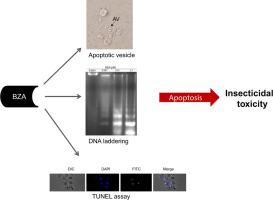Journal of Asia-Pacific Entomology ( IF 1.1 ) Pub Date : 2020-03-18 , DOI: 10.1016/j.aspen.2020.03.008 Md. Mahi Imam Mollah , Fatema Yeasmin , Yonggyun Kim

|
Xenorhabdus and Photorhabdus are entomopathogenic bacteria that can induce immunosuppression against target insects by suppressing eicosanoid biosynthesis, leading to fatal septicemia. These bacteria can synthesize and release secondary metabolites such as benzylideneacetone (BZA) and other phenylethylamide compounds that can inhibit phospholipase A2 (PLA2) and shut down eicosanoid biosynthesis. However, insecticidal activities of these bacterial metabolites remain unclear. Thus, the objective of this study was to assess cytotoxicities of BZA and seven other bacterial metabolites to insect cells. These eight bacterial metabolites exhibited significant cytotoxicities against an insect cell line Sf9 at micromolar range. Especially, BZA and cPY were highly potent at low micromolar range. When these eight bacterial metabolites were injected to hemocoels of Spodoptera exigua larvae, they significantly decreased total count of hemocytes. In Sf9 cell line and hemocytes, these bacterial metabolites induced cell membrane blebbings, apoptotic vesicles, and genomic DNA fragmentation. Terminal deoxyribonucleotidyl transferase nick end translation assay showed that these bacterial metabolites caused significant DNA breakages in cells in a dose-dependent manner. However, a pan caspase inhibitor treatment significantly rescued the cell death induced by these bacterial metabolites. Cytotoxicities of these bacterial metabolites were highly correlated with their insecticidal activities. These results indicate that the insecticidal activities of the bacterial metabolites may be induced by their apoptotic activities against hemocytes and other insect cells. Taken together, these results suggest that phenylethylamide compounds might have potential as novel insecticides.
中文翻译:

亚苄基丙酮和其他苯乙酰胺细菌代谢物诱导细胞凋亡杀死昆虫
Xenorhabdus和Photorhabdus是致病性细菌,可以通过抑制类花生酸生物合成来诱导针对目标昆虫的免疫抑制,从而导致致命的败血病。这些细菌可以合成和释放次级代谢产物,例如亚苄基丙酮(BZA)和其他可以抑制磷脂酶A 2(PLA 2)并停止类花生酸的生物合成。然而,这些细菌代谢产物的杀虫活性仍不清楚。因此,本研究的目的是评估BZA和其他7种细菌代谢产物对昆虫细胞的细胞毒性。这八种细菌代谢物在微摩尔范围内对昆虫细胞系Sf9表现出显着的细胞毒性。特别是,BZA和cPY在低微摩尔范围内具有很高的效力。当将这八种细菌代谢物注射到斜纹夜蛾的血球中时幼虫,它们显着减少了血细胞总数。在Sf9细胞系和血细胞中,这些细菌代谢产物诱导细胞膜起泡,凋亡小泡和基因组DNA断裂。末端脱氧核糖核苷酸转移酶缺口末端翻译试验表明,这些细菌代谢产物以剂量依赖的方式在细胞中引起明显的DNA断裂。但是,泛半胱天冬酶抑制剂治疗可显着挽救这些细菌代谢产物诱导的细胞死亡。这些细菌代谢产物的细胞毒性与其杀虫活性高度相关。这些结果表明,细菌代谢物对血细胞和其他昆虫细胞的凋亡活性可诱导其杀虫活性。在一起











































 京公网安备 11010802027423号
京公网安备 11010802027423号